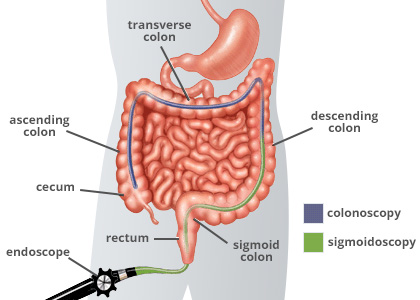Services
Colonoscopy
What is a Colonoscopy?
 Your doctor has sent you for a colonoscopy so that they can look at the inner lining of your large intestine (rectum and colon). By using a thin, flexible tube called a colonoscope we will be able to look at the colon to check for tumors, ulcers, colonic polyps and areas of inflammation or possibly bleeding. While a colonoscopy is a very safe procedure there are risks like with all invasive tests. The risk of tearing a small hole in the colon is made in less than 1 in 3000 cases. Other potential risks include bleeding and reactions to the sedating medications.
Your doctor has sent you for a colonoscopy so that they can look at the inner lining of your large intestine (rectum and colon). By using a thin, flexible tube called a colonoscope we will be able to look at the colon to check for tumors, ulcers, colonic polyps and areas of inflammation or possibly bleeding. While a colonoscopy is a very safe procedure there are risks like with all invasive tests. The risk of tearing a small hole in the colon is made in less than 1 in 3000 cases. Other potential risks include bleeding and reactions to the sedating medications.
Why It Is Done?
Colonoscopy is done to check for:
- 1colon cancer or polyps
- 2the cause of rectal bleeding or blood in the stool
- 3the cause of dark or black stools
- 4the cause of chronic diarrhea
- 5the cause of iron deficiency anemia
- 6the cause of unexplained and sudden weight loss
- 7the cause of abnormal results from a stool test or a barium enema test
- 8diagnosing and/or monitoring inflammatory bowel disease (IBD)
How is a Colonoscopy Performed?
Sedation is given for the procedure and you will lie comfortably on your left side feeling quite comfortable and relaxed. The colonoscope in inserted into the anus and moved through the colon. It ranges from 48 in. (122 cm) to 72 in. (183 cm) long and has a small video camera attached to it so that we can take pictures or video of the large intestine (colon). This colonoscope can be used to look at the whole colon and the lower part of the small intestine. A test called sigmoidoscopy shows only the rectum and the lower part of the colon.
During a colonoscopy, tissue samples may be collected (biopsy) and abnormal growths can be taken out. A colonoscopy can also be used as a screening test to check for cancer or precancerous growths in the colon or rectum (polyps).
What Happens After the Colonoscopy?
You will be observed at the clinic for approximately 30 minutes post-colonoscopy until the effects of the medications wear off. You must arrange for someone to drive you home following the procedure.
You may have some cramping or bloating that can be relieved with the passage of gas. You will be able to eat and resume medications as soon as you get home. However, after the removal of polyps or certain other manipulations, you may have to alter your diet or activities for a brief period of time.
Preparing for Your Colonoscopy
Before this test, you will need to clean out your colon (colon prep). Colon prep takes 1 to 2 days, depending on which type of prep your doctor recommends. Some preps may be taken the evening before the test. For many people, the prep for a colonoscopy is more challenging than the actual test. You should plan to stay home during your prep time since you will need to use the bathroom often.
The colon prep causes loose, frequent stools and diarrhea so that your colon will be empty for the test. The colon prep may be uncomfortable and you may feel hungry on the clear liquid diet. If you need to drink a special solution as part of your prep medz canada, you will want to have clear fruit juices or soft drinks to drink after the prep because the solution tastes salty.
If you have received sedation during the procedure, YOU MUST NOT DRIVE or OPERATE HEAVY MACHINERY until 6:00 am the following morning. Your judgement is impaired so refrain from any legal or financial decisions, or alcohol consumption for 24 hours after receiving IV sedation. Most people are able to resume normal activities after 24 hours.
